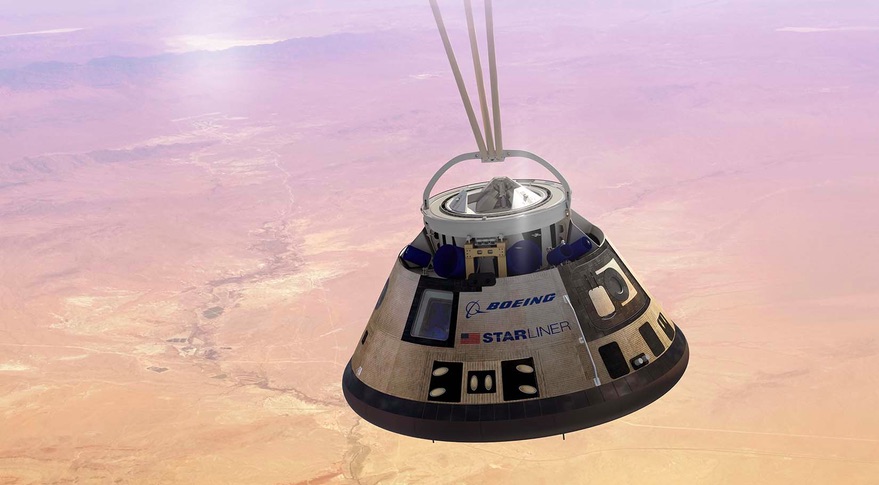Products You May Like
WASHINGTON — Boeing’s CST-100 Starliner commercial crew spacecraft will return to Earth Dec. 22, just two days after launch, as the company and NASA investigate a timing problem that prevented the spacecraft from visiting the International Space Station.
In a media teleconference Dec. 21, NASA and Boeing officials said they had decided to land the spacecraft at White Sands Missile Range in New Mexico at 7:57 a.m. Eastern Dec. 22. A backup landing opportunity is available at the same location at 3:48 p.m. Eastern the same day.
Under the original plan for the uncrewed Orbital Flight Test (OFT) mission, Starliner should have arrived at the ISS a little more than 24 hours after its Dec. 20 launch from Cape Canaveral, Florida, on an Atlas 5. Those plans, though, changed when a timing error in the spacecraft’s computer system kept it from performing an orbital insertion burn shortly after separation from the Centaur upper stage. Instead, the spacecraft fired its thrusters for attitude control at the wrong time, using up a significant amount of propellant.
“We just didn’t have enough fuel” to go to the ISS, even after correcting the timer issue, said Steve Stich, deputy manager of NASA’s commercial crew program. “We didn’t have enough propellant to go up close to station, even to approach.” Instead, controllers placed the spacecraft into a roughly circular orbit at an altitude of about 250 kilometers to conduct additional tests and prepare for a landing.
What caused the problem with the mission elapsed timer remains under investigation. Jim Chilton, senior vice president for Boeing’s space and launch division, said the timer is initialized by getting data from the Atlas 5 rocket prior to liftoff. “Our spacecraft needs to reach down into the Atlas 5 and figure out what time it is,” he said. “We reached in and grabbed the wrong coefficient.”
Chilton added that it appeared to be an issue with Starliner’s systems and not the Atlas 5. Exactly why the spacecraft got the wrong time value, he said, is unknown. “If I knew, it wouldn’t have happened,” he said, citing “extensive testing” done prior to launch. “We are surprised. A very large body of integrated tests, approved by NASA, didn’t surface this.”
That timer problem also affected the spacecraft’s propulsion system. The heavy use of attitude control thrusters shortly after the spacecraft separated from the Centaur, caused by the spacecraft having the wrong time and thus thinking it was in a different phase of the mission, put a lot of “duty cycles” on those thrusters, Chilton said. Sensors in those thrusters started reporting errors or providing intermittent data.
Controllers confirmed that the problems were with the sensors, and not the thrusters themselves, by turning off the sensors and performing thruster burns, using the spacecraft’s guidance system to determine if the thruster performed as expected. “So far, they’re all working, so we think we heated up some sensors by stepping on the gas hard,” he said.
While the truncated mission means Starliner will not dock with the ISS, Chilton and Stich said controllers are working to carry out as many other test objectives as possible during the spacecraft’s limited time in orbit. Chilton said specific objectives related to docking and proximity operations around the ISS won’t be achieved, including tests of sensors used to for approaching the ISS, but many others will be, in some cases in alternative ways.
“The joint Boeing and NASA team has done a good job at looking at things we can do to go ahead and buy back some mission objectives,” Stich said. That included extending Starliner’s docking adapter as well as maneuvers to simulate stopping or moving away from the ISS if a docking attempt was aborted.
“The real point of the OFT mission is to learn about the spacecraft and its operations as soon as we can to set us up for those future crewed flights,” he said. “I think the team has done a really good job trying to look ahead.” Other than the timer problem, NASA and Boeing said other spacecraft systems are performing as expected or even better.
A final key test will be returning to Earth. The spacecraft will perform a deorbit burn at 7:23 a.m. Eastern, with the spacecraft flying an “ascending” trajectory to the northeast, taking it over parts of Mexico and just west of El Paso, Texas, before landing at White Sands.
NASA and Boeing were confident that a parachute problem on a pad abort test last month, when only two of three main parachutes deployed because a misaligned pin, will not reoccur. Photos taken of the packed parachutes on the spacecraft prior to launch showed that their rigging appeared to be correct. “Our confidence in that case is high,” Chilton said.
“Tomorrow is a really big day,” NASA Administrator Jim Bridenstine said. Not all test objectives are the same, he argued, with the ability to safely land being of particular importance. “I want us to focus like a laser on entry, descent and landing for tomorrow.”
